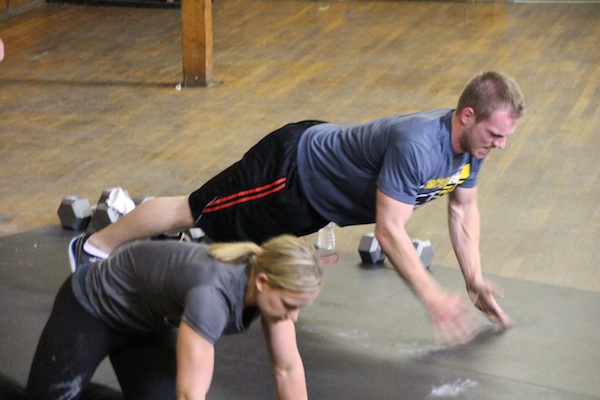
Here are the FACT’s…
The more control you have over your movement capacity — external (as in the case of lifting weights) or internal (as in the case of bodyweight training) — the better you will look, feel, and perform.
So, how do you make constant gains by inserting Progressive Movement Technology™ into your workouts?
It’s really quite simple.
First, start with the basic movements of the human body—things like squats, deadlifts, presses, pulls, pushes, rows, and core stability. And second, create a series of more difficult variations for each of the exercises.
Here are examples for both bodyweight and weighted movement progressions. Once you can do 3 sets of 10 reps on each (A) exercise, simply move on to the next variation (B, C, D, etc.) until you can again do 3 sets of 10 reps of the new exercise..
BODYWEIGHT EXAMPLE:
(A) Kneeling Pushups —–> (B) Regular Pushups —–> (C) Clap Pushups —–> (D) Vertical Pike Presses —–> (E) Handstand Pushups
WEIGHTED EXAMPLE: (Use The Same Weight For Each)
(A) Deadlift —–> (B) One Arm Deadlift —–> (C) One Arm Swing —–> (D) One Arm High Pull —–> (E) One Arm Snatch
As you can see, in both of these cases the weights you are moving and/or your bodyweight do not change. Instead, the complexity of the movement changes. The reason this is so poerful is because of the way your nervous system responds to adaptations of movement complexity.
Imagine unlocking new strength and coordination in your muscles that you might not even know you have.
And the best part…
You don’t have to stop training the way you currently love! In fact, you can continue your training program and just add 10-20 minutes of progressive movement cross training 2-3 times each week to get great results!
The key with progressive movement training is to consistently up your game by mastering one movement and then simply moving up the ladder to the next, more difficult movement. The amount of time doesn’t really matter, only that you keep moving forward.
By adding this style of training to your workouts, you’ll allow your body to adapt to movements you might not normally do. Along the way, you’ll build a body that looks, feels, and performs the best it possibly can.
***
If you’re into learning more ways to include progressive movement training into your workouts and tack them onto the end of hard training sessions check out Tyler’s NEW CT-50 system.







0 comments:
Post a Comment